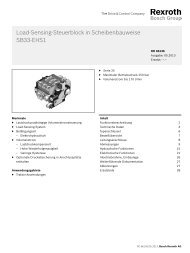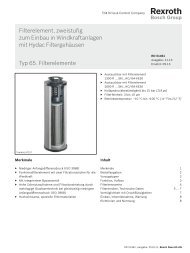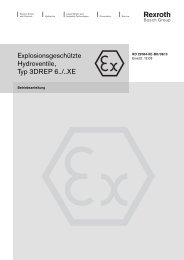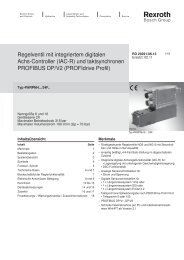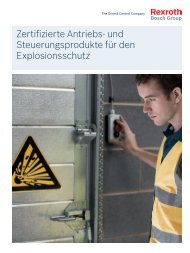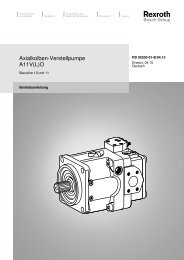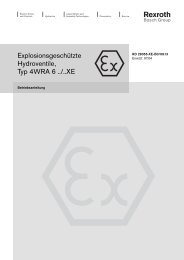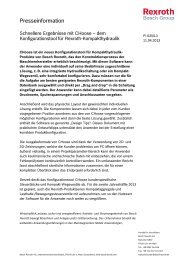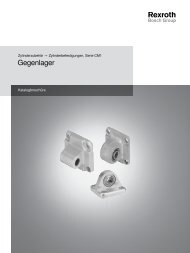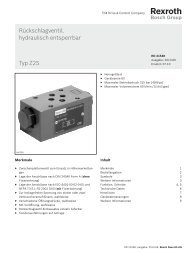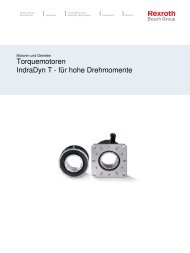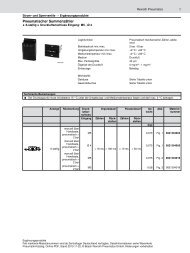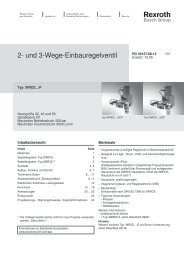5 Druck- und Differenzdruckregler Controllers for ... - Bosch Rexroth
5 Druck- und Differenzdruckregler Controllers for ... - Bosch Rexroth
5 Druck- und Differenzdruckregler Controllers for ... - Bosch Rexroth
You also want an ePaper? Increase the reach of your titles
YUMPU automatically turns print PDFs into web optimized ePapers that Google loves.
y<br />
Anwendungen<br />
Dynamische <strong>und</strong> energiesparende<br />
Pumpenverstellungen werden durch<br />
die Kombination einer Radialkolbenpumpe<br />
(RKP) mit einem Regelventil<br />
erreicht.<br />
Durch Einbindung der Pumpe in einen<br />
<strong>Druck</strong>regelkreis lassen sich dynamische<br />
<strong>Druck</strong>regelungen realisieren.<br />
Der dafür er<strong>for</strong>derliche p/Q-Regelverstärker<br />
besteht aus einer Basiskarte<br />
mit Frontplatte, welche den Ventilverstärker<br />
mit Lageregelung enthält<br />
sowie einer aufgesteckten Tochterkarte,<br />
auf der die eigentliche <strong>Druck</strong>regelung<br />
realisiert ist.<br />
Diese Verstärker werden nur als vollständige<br />
Kombinationen geliefert. In<br />
Verbindung mit dem entsprechendem<br />
Regelventil <strong>und</strong> <strong>Druck</strong>sensor (siehe<br />
UBY 013/100 <strong>und</strong> UBY 013/123)<br />
können Volumenströme gesteuert <strong>und</strong><br />
Drücke im geschlossenen Regelkreis<br />
geregelt werden.<br />
Eingangsgrößen sind die Sollwerte<br />
von <strong>Druck</strong> p <strong>und</strong> Volumenstrom Q. Als<br />
Istwerte werden <strong>Druck</strong>, Schieberlage<br />
PL-Ventil <strong>und</strong> Hubringlage rückgeführt.<br />
Weiterhin ist auf der Karte eine Schaltung<br />
zur Leckölkompensation enthalten,<br />
um damit die druckabhängigen,<br />
volumetrischen Verluste der Pumpe<br />
weitestgehend auszugleichen.<br />
An den Karten « 0 811 405 159 <strong>und</strong><br />
« 0 811 405 160 können <strong>Druck</strong>sensoren<br />
mit Spannungs- <strong>und</strong> Stromsignal<br />
angeschlossen werden.<br />
Die Karten « 0 811 405 110 <strong>und</strong><br />
« 0 811 405 125 sind nur für Sensoren<br />
mit Spannungssignal geeignet <strong>und</strong><br />
für Neuanwendungen nicht mehr einzusetzen.<br />
Die Karten « 0 811 405 125 <strong>und</strong><br />
« 0 811 405 160 müssen immer in<br />
Verbindung mit dem Regelventil «<br />
0 811 404 163 eingesetzt werden. Die<br />
Sonderfunktion „Spülschaltung“ erfaßt<br />
Änderungen der Sollwertvorgaben<br />
<strong>Druck</strong> p <strong>und</strong> Volumenstrom Q.<br />
Ist einer der Sollwerte länger als<br />
ca. 4 min 0 V, wird das Ventil in Spülstellung<br />
gehen.<br />
Ziel: Erwärmungsreduzierung der<br />
Pumpe. Dieser Wartezustand wird<br />
durch das Blinken der gelben LEDs<br />
(re. Reihe) auf der Frontplatte angezeigt,<br />
sowie durch einen aktiven<br />
Fehlerausgang z22 gemeldet. Die<br />
Mindestvorgabe wenigstens eines<br />
Sollwertes beträgt > 100 mV, um die<br />
Spülschaltung wieder zu deaktivieren.<br />
yy<br />
Applications<br />
Dynamic and energy-saving pump<br />
control can be attained by combining<br />
a radial piston pump (RPP) with a<br />
servo solenoid valve.<br />
By integrating the pump in a pressurecontrol<br />
circuit, dynamic pressure control<br />
can be achieved.<br />
The p/Q amplifier required <strong>for</strong> this purpose<br />
consists of a base card with<br />
front plate, containing the valve amplifier<br />
with position control, and a daughter<br />
card. The daughter card, inserted<br />
in the base card, is where the actual<br />
pressure control process occurs. This<br />
amplifier is only available as a single<br />
combination unit. When used together<br />
with the appropriate servo solenoid<br />
valve and pressure sensor (see<br />
UBY 013/100 and UBY 013/123), this<br />
unit can be employed <strong>for</strong> controlling<br />
flow and pressure in a closed-loop<br />
control circuit.<br />
The input parameters are the setpoints<br />
<strong>for</strong> pressure p and flow Q. Feedback<br />
values are pressure, spool position of<br />
PL valve and stroke ring position.<br />
The card also contains a circuit <strong>for</strong><br />
leakage-oil compensation which, to<br />
a large extent, offsets the volumetric<br />
pump losses resulting from increased<br />
pressure.<br />
Cards « 0 811 405 159 and<br />
« 0 811 405 160 are <strong>for</strong> the connection<br />
of pressure sensors with both<br />
voltage and current signals.<br />
Cards « 0 811 405 110 and<br />
« 0 811 405 125 are only suitable<br />
<strong>for</strong> sensors with voltage signal and<br />
should no longer be used <strong>for</strong> new<br />
applications.<br />
The cards « 0 811 405 125 and<br />
« 0 811 405 160 always be used in<br />
conjunction with the servo solenoid<br />
valve « 0 811 404 163. The special<br />
“Scavenging operation” function records<br />
changes in the setpoint defaults<br />
pressure p and volumetric flow rate Q.<br />
If one of the setpoints is 0 V <strong>for</strong> longer<br />
than approx. 4 min., the valve goes<br />
into scavenging setting.<br />
Aim: to keep the temperature down in<br />
the pump. This standby condition is<br />
indicated by the flashing of the yellow<br />
LED’s (right-hand row) on the front<br />
plate, and through an active error output<br />
z22.<br />
To deactivate scavenging operation,<br />
the minimum default of at least one<br />
setpoint equals > 100 mV.<br />
yyy<br />
Applications<br />
Industrial Hydraulics 133<br />
Des réglages dynamiques et économiques<br />
de la pompe sont rendus possibles<br />
grâce à la combinaison d’une<br />
pompe à pistons radiaux et d’un<br />
servo-distributeur.<br />
L’intégration de la pompe dans un<br />
circuit de régulation de la pression<br />
permet de réaliser des réglages dynamiques<br />
de la pression.<br />
L’amplificateur de réglage p/Q se<br />
compose d’une carte de base avec<br />
plaque frontale, qui comprend l’amplificateur<br />
du distributeur à régulation de<br />
position, et d’une carte fille enfichée<br />
où se déroule effectivement la régulation<br />
de pression. Ces amplificateurs<br />
sont uniquement livrés par combinaisons<br />
complètes. En association<br />
avec les servo-distributeurs et les<br />
capteur de pression adéquats (voir<br />
UBY 013/100 et UBY 013/123), il est<br />
possible de contrôler les débits et de<br />
réguler les pressions en circuit fermé.<br />
Les signaux d’entrée sont les valeurs<br />
de consigne de la pression p et du<br />
débit Q.<br />
La pression, la position du tiroir de la<br />
valve PL et la position de la bague de<br />
cylindrée sont retournées en tant que<br />
signaux de retour.<br />
La carte comprend en outre un circuit<br />
de compensation de l’huile de fuite,<br />
afin de compenser au maximum les<br />
pertes volumétriques dépendant de la<br />
pression de la pompe.<br />
Des capteurs de pression avec signal<br />
de tension et de courant peuvent être<br />
raccordés aux cartes « 0 811 405 159<br />
et « 0 811 405 160.<br />
Les cartes « 0 811 405 110 et<br />
« 0 811 405 125 ne conviennent<br />
que pour des capteurs avec signal de<br />
tension et ne doivent plus être utilisées<br />
pour de nouvelles applications.<br />
Les cartes « 0 811 405 125 et<br />
« 0 811 405 160 doivent toujours être<br />
mises en œuvre conjointement avec le<br />
distributeur « 0 811 404 163. La fonction<br />
spéciale «circuit de rinçage»<br />
détecte les variations des consignes<br />
de pression p et de débit volumique<br />
Q. Si l’une des valeurs de consigne<br />
est sur 0 V pendant plus de 4 min., la<br />
valve retourne en position de rinçage.<br />
Objectif: réduction de l’échauffement<br />
de la pompe. Ce mode d’attente est<br />
signalé par le clignotement des LED<br />
jaunes (rangée de droite) sur la plaque<br />
frontale ainsi que par une sortie défaut<br />
active z22.<br />
La spécification minimale d’une consigne<br />
est > 100 mV pour désactiver à<br />
nouveau le circuit de rinçage.<br />
5



